Solar Power and Energy Storage for Decarbonization of Land Transport in India
Abstract
:1. Introduction
2. Method
2.1. Feasibility of Battery-Electric Vehicles (BEVs)
2.2. Growth of Demand for Transport and Transition to Clean Energy
- Transport demand and use is the same per capita as the UK in 2017 in terms of passenger-km and tonne-km travelled.
- Modal differences compared to the UK: More autorickshaws, more two-wheelers, more buses, more trains, but fewer private cars.
- Land-based forms of transport will use BEVs where possible, with an improvement in efficiency, consistent with electric motors compared to petrol engines or diesel engines.
- Forms of transport not suitable for battery electrification will use compressed hydrogen gas. The improvement in energy efficiency results from the use of fuel cells compared to diesel engines.
2.3. Temporal Variation in Public Transport Use
2.4. Renewable Energy Scenario for India including Transport Energy
2.5. Electric Vehicle Charging Options
3. Results
3.1. Batteries as a Proportion of Unladen Vehicle Mass
3.2. Growth in Demand for Transport and Transport Energy Demand Scenarios
3.3. Transition to Low-Carbon Transport Technologies
3.4. Time of Use of Pasenger Vehicles
3.5. Renewable Energy Scenarios for India including Transport Energy
3.6. Grid Balancing and BEV Charging Options
3.7. Economics of BEVs and Charging Strategy
- 1.
- Imported technology vs. indigenously manufactured;
- 2.
- Economies of scale, learning rates and market maturation rates between now and year 2050;
- 3.
- Availability of other infrastructure e.g., grid connection at overnight parking locations;
- 4.
- Willingness of drivers to have routine disrupted by charging;
- 5.
- Taxes, government incentives and regulations.
4. Discussion of Future Research
5. Conclusions
Author Contributions
Funding
Institutional Review Board Statement
Informed Consent Statement
Data Availability Statement
Conflicts of Interest
Glossary
| BEV | Battery Electric Vehicle |
| CNG | Compressed Natural Gas |
| CO | Carbon Monoxide |
| CSP | Concentrating Solar Power |
| FCV | Fuel Cell Vehicle |
| GHGs | Greenhouse Gases |
| ICE | Internal Combustion Engine |
| LPG | Liquid Petroleum Gas |
| NOx | Oxides of Nitrogen |
| PV | Solar Photovoltaic |
Appendix A
| Location Name | Form of Transport | Location in City | City or Region |
|---|---|---|---|
| Churchgate | Local Train | Centre | Mumbai |
| CSM Terminus | Distance Train | Centre | Mumbai |
| Jogeshwari | Local Train | Halfway | Mumbai |
| Versova | Metro | Halfway | Mumbai |
| Ghatkopar | Metro | Halfway | Mumbai |
| Ghatkopar | Local Train | Halfway | Mumbai |
| Khandwa Junction | Distance Train | Small Town | Madhya Pradesh |
| New Delhi | Distance Train | Centre | New Delhi |
| New Delhi | Metro | Centre | New Delhi |
| Rohini | Metro | Outer | New Delhi |
| Rithala | Metro | Outer | New Delhi |
| Dwarka | Metro | Outer | New Delhi |
| IndusInd | Metro | Halfway | New Delhi |
| Sector 55–56 | Metro | Outer | New Delhi |
| Shalimar | Metro | Outer | New Delhi |
| Faridabad | Local Train | Halfway | New Delhi |
| Escorts Mujesar | Metro | Halfway | New Delhi |
| Wave | Metro | Outer | New Delhi |
| Dainik | Metro | Outer | New Delhi |
| Mundka | Metro | Outer | New Delhi |
| Kirti Nagar | Metro | Halfway | New Delhi |
| Inderlok | Metro | Halfway | New Delhi |
| Kashmere Gate | Metro | Centre | New Delhi |
| Dilshad | Metro | Outer | New Delhi |
| Anand Vihar | Bus | Halfway | New Delhi |
| Kolkata | Distance Train | Centre | Kolkata |
| Tikiapara | Local Train | Halfway | Kolkata |
| Noapara | Metro | Outer | Kolkata |
| Uttarpara | Local Train | Halfway | Kolkata |
| Kamarkundu | Local Train | Halfway | Kolkata |
| Thakurpukur | Bus | Outer | Kolkata |
| Birati | Bus | Outer | Kolkata |
| Coonoor | Local Train | Small Town | Tamil Nadu |
| Krantivira | Distance Train | Centre | Bengaluru |
| City | Metro | Centre | Bengaluru |
| Mysuru Rd | Metro | Outer | Bengaluru |
| Baiyappanahalli | Metro | Halfway | Bengaluru |
| Baiyyappanahali | Local Train | Halfway | Bengaluru |
| Nadaprabhu | Metro | Centre | Bengaluru |
| Yelachenahalli | Metro | Outer | Bengaluru |
| Nagasandra | Metro | Outer | Bengaluru |
| Nadaprabhu | Bus | Centre | Bengaluru |
| Electronic City | Bus | Halfway | Bengaluru |
| Chennai Beach | Local Train | Centre | Chennai |
| Washermanpet | Local Train | Halfway | Chennai |
| Ennore | Local Train | Halfway | Chennai |
| Gumto | Distance Train | Small Town | Arunchal |
| Harmuti Junction | Distance Train | Small Town | Assam |
| Tezpur | Distance Train | Centre | Tezpur |
| Dekargaon | Distance Train | Halfway | Tezpur |
References
- EBTC. Report on Transport and Energy in India. Turin Torino; 2013. Available online: http://ebtc.eu/pdf/130925_REP_Report-on-Transport-and-Energy-in-India_Web.pdf (accessed on 25 September 2013).
- Paladugula, A.L.; Kholod, N.; Chaturvedi, V.; Ghosh, P.P.; Pal, S.; Clarke, L.; Evans, M.; Kyle, P.; Koti, P.N.; Parikh, K.; et al. A multi-model assessment of energy and emissions for India’s transportation sector through 2050. Energy Policy 2018, 116, 10–18. [Google Scholar] [CrossRef]
- Dhar, S.; Pathak, M.; Shukla, P.R. Transformation of India’s transport sector under global warming of 2 °C and 1.5 °C scenario. J. Clean. Prod. 2018, 172, 417–427. [Google Scholar] [CrossRef] [Green Version]
- Karstensen, J.; Roy, J.; Deb Pal, B.; Peters, G.; Andrew, R. Key drivers of Indian greenhouse gas emissions. Econ. Polit. Wkly. 2020, 55, 46–53. [Google Scholar]
- Ge, M.; Friedrich, J. 4 Charts Explain Greenhouse Gas Emissions by Countries and Sectors; World Resources Institute: Washington, DC, USA, 2020; Available online: https://www.wri.org/insights/4-charts-explain-greenhouse-gas-emissions-countries-and-sectors (accessed on 26 May 2021).
- Singh, A.; Gangopadhyay, S.; Nanda, P.K.; Bhattacharya, S.; Sharma, C.; Bhan, C. Trends of greenhouse gas emissions from the road transport sector in India. Sci. Total Environ. 2008, 390, 124–131. [Google Scholar] [CrossRef] [PubMed]
- Ritchie, H.; Roser, M. CO2 and Greenhouse Gas Emissions. Our World in Data. 2020. Available online: https://ourworldindata.org/co2-and-other-greenhouse-gas-emissions# (accessed on 26 May 2021).
- Misra, P.; Takeuchi, W. Analysis of air quality in Indian cities using remote sensing and economic growth parameters. In Proceedings of the ACRS 2015—36th Asian Conference on Remote Sensing: Fostering Resilient Growth in Asia, Quezon City, Philippines, 24–28 October 2015. [Google Scholar]
- Gulia, S.; Nagendra, S.M.S.; Barnes, J.; Khare, M. Urban local air quality management framework for non-attainment areas in Indian cities. Sci. Total Environ. 2018, 619, 1308–1318. [Google Scholar] [CrossRef] [PubMed]
- Guttikunda, S.K.; Goel, R.; Pant, P. Nature of air pollution, emission sources, and management in the Indian cities. Atmos. Environ. 2014, 95, 501–510. [Google Scholar] [CrossRef]
- Shrivastava, R.; Neeta, S.; Geeta, G. Air pollution due to road transportation in India: A review on assessment and reduction strategies. J. Environ. Res. Dev. 2013, 8, 69. [Google Scholar]
- Dhar, S.; Shukla, P.R. Low carbon scenarios for transport in India: Co-benefits analysis. Energy Policy 2015, 81, 186–198. [Google Scholar] [CrossRef] [Green Version]
- Audoly, R.; Vogt-Schilb, A.; Guivarch, C.; Pfeiffer, A. Pathways toward zero-carbon electricity required for climate stabilization. Appl. Energy 2018, 225, 884–901. [Google Scholar] [CrossRef] [Green Version]
- SESEI. Study Report on Automotive “ITS and E-Mobility”; SESEI: Delhi, India, 2020; Available online: https://ebtc.eu/admin/images/posts/107/180402StudyonITSandEmobility.pdf (accessed on 17 August 2021).
- Shukla, P.R.; Chaturvedi, V. Low carbon and clean energy scenarios for India: Analysis of targets approach. Energy Econ. 2012, 34, S487–S495. [Google Scholar] [CrossRef]
- WRI. India Reaffirms Ambitious Renewable Energy Target at United Nations. 2021. Available online: https://www.wri.org/news/statement-india-reaffirms-ambitious-renewable-energy-target-united-nations (accessed on 6 December 2021).
- Government of India. India Energy Security Scenarios 2047. 2015. Available online: http://iess2047.gov.in/pathways/44404444444444440444444444014444404424444444404440444022222/primary_energy_chart (accessed on 13 August 2021).
- IPCC. IPCC Special Report Global Warming of 1.5 °C. 2018. Available online: https://www.ipcc.ch/sr15/ (accessed on 5 October 2021).
- NITI Aayog; RMI. India’s Electric Mobility Transformation: Progress to Date and Future Opportunities. 2019. Available online: http://niti.gov.in/writereaddata/files/document_publication/NITI-RMI-Report.pdf (accessed on 19 August 2021).
- Popovich, N.D.; Rajagopal, D.; Tasar, E.; Phadke, A. Economic, environmental and grid-resilience benefits of converting diesel trains to battery-electric. Nat. Energy 2021, 6, 1017–1025. Available online: https://www.nature.com/articles/s41560-021-00915-5.pdf (accessed on 26 November 2021). [CrossRef]
- Staples, M.D.; Malina, R.; Barrett, S.R.H. The limits of bioenergy for mitigating global life-cycle greenhouse gas emissions from fossil fuels. Nat. Energy 2017, 2, 16202. Available online: https://www.nature.com/articles/nenergy2016202.pdf (accessed on 24 August 2021). [CrossRef]
- Mittal, S.; Ahlgren, E.O.; Shukla, P.R. Future biogas resource potential in India: A bottom-up analysis. Renew. Energy 2019, 141, 379–389. Available online: https://www.sciencedirect.com/science/article/pii/S0960148119304549 (accessed on 24 August 2021). [CrossRef]
- Owen, B.; Lee, D.S.; Lim, L. Flying into the future: Aviation Emissions Scenarios to 2050. Environ. Sci. Technol. 2010, 44, 2255–2260. Available online: https://pubs.acs.org/doi/pdf/10.1021/es902530z (accessed on 24 August 2021). [CrossRef] [PubMed]
- Lee, D.S.; Fahey, D.W.; Forster, P.M.; Newton, P.J.; Wit, R.C.; Lim, L.L.; Owen, B.; Sausen, R. Aviation and global climate change in the 21st century. Atmos. Environ. 2009, 43, 3520–3537. Available online: https://www.sciencedirect.com/science/article/pii/S1352231009003574#fig3 (accessed on 24 August 2021). [CrossRef] [PubMed] [Green Version]
- Rowlatt, J. Why Electric Cars will Take over Sooner than You Think. BBC News. 24 August 2021. Available online: https://www.bbc.co.uk/news/business-57253947 (accessed on 24 August 2021).
- Khandekar, A.; Rajagopal, D.; Abhyankar, N.; Deorah, S.; Phadke, A. The Case for All New City Buses in India to Be Electric. 2018. Available online: https://escholarship.org/content/qt7d64m1cd/qt7d64m1cd_noSplash_ffa60ca3f169642318a55378994911ab.pdf?t=pjiibx (accessed on 17 September 2021).
- Ajanovic, A.; Haas, R. Economic and Environmental Prospects for Battery Electric- and Fuel Cell Vehicles: A Review. Fuel Cells 2019, 195, 515–529. [Google Scholar] [CrossRef] [Green Version]
- IESA. India Electric Vehicle Market Overview Report; IESA: Pune, India, 2020; Available online: https://indiaesa.info/media/downloadfiles/EV_Report_Brochure._234429529.pdf (accessed on 17 August 2021).
- Saxena, S.N. Two- and Three- Wheeler Electric Vehicles in India—Outlook 2019. Int. J. Electr. Eng. Technol. 2019, 9, 13. Available online: http://ripublication.com/ijeet19/ijeetv9n1_01.pdf (accessed on 24 August 2021).
- Ligen, Y.; Vrubel, H.; Girault, H.H. Mobility from Renewable Electricity: Infrastructure Comparison for Battery and hydrogen Fuel Cell Vehicles. World Electr. Veh. J. 2018, 9, 12. [Google Scholar] [CrossRef] [Green Version]
- IOR Energy. Engineering Conversion Factors. 2010. Available online: https://web.archive.org/web/20100825042309/http://www.ior.com.au/ecflist.html (accessed on 6 December 2021).
- PushEVs. 2018 Nissan Leaf Battery Real Specs. 2021. Available online: https://pushevs.com/2018/01/29/2018-nissan-leaf-battery-real-specs/ (accessed on 28 May 2021).
- Sibelga. How Much Power Does an Electric Car Use? All about Energy in Brussels. 2021. Available online: https://www.energuide.be/en/questions-answers/how-much-power-does-an-electric-car-use/212/ (accessed on 3 July 2018).
- Idaho National Laboratory. Comparing Energy Costs per Mile for Electric and Gasoline-Fueled Vehicles. Advanced Vehicle Testing Activity. 2011. Available online: https://avt.inl.gov/sites/default/files/pdf/fsev/costs.pdf (accessed on 3 December 2014).
- Gao, Z.; Lin, Z.; LaClair, T.J.; Liu, C.; Li, J.M.; Birky, A.K.; Ward, J. Battery capacity and recharging needs for electric buses in city transit service. Energy 2017, 122, 588–600. [Google Scholar] [CrossRef] [Green Version]
- Pinna, I.; Dalla Chiara, B.; Pant, K. Energy used by transport systems in India: The role of the urban population, sources, alternative modes and quantitative analyses. WIT Trans. Ecol. Environ. 2014, 190, 661–676. Available online: https://www.witpress.com/Secure/elibrary/papers/EQ14/EQ14063FU1.pdf (accessed on 16 August 2021).
- ITF. Decarbonising India’s Transport System. Charting the Way Forward. 2020. Available online: https://www.itf-oecd.org/decarbonising-india-transport-system (accessed on 27 July 2021).
- Clark, H.; Frankland, C. Digest of United Kingdom Energy Statistics 2018. Chapter 1, Electricity. 2018. Available online: https://assets.publishing.service.gov.uk/government/uploads/system/uploads/attachment_data/file/736148/DUKES_2018.pdf (accessed on 16 August 2021).
- Government of India. Census of India 2011. Houses, Household Amenities and Assets. Figures at a Glance. 2011. Available online: Censusindia.gov.in/2011census/hlo/Data_sheet/India/Figures_Glance.xls (accessed on 16 August 2021).
- United Nations. World Population Prospects. Volume I. 2019. Available online: https://population.un.org/wpp/Publications/Files/WPP2019_Volume-I_Comprehensive-Tables.pdf (accessed on 14 July 2021).
- Mordor Intelligence. India Electric Vehicle (EV) Market—Growth, Trends, COVID-19 Impact, and Forecasts (2021–2026). 2021. Available online: https://www.mordorintelligence.com/industry-reports/india-electric-vehicle-market (accessed on 17 August 2021).
- Nakamoto, Y.; Nishijima, D.; Kagawa, S. The role of vehicle lifetime extensions of countries on global CO2 emissions. J. Clean. Prod. 2019, 207, 1040–1046. [Google Scholar] [CrossRef]
- US Department of Energy Office of Energy Efficiency and Renewable Energy. Compare Fuel Cell Vehicles; Oak Ridge National Laboratory: Oak Ridge, TN, USA, 2016. Available online: https://www.fueleconomy.gov/feg/fcv_sbs.shtml (accessed on 13 July 2021).
- National Statistics. 2017 National Travel Survey. 2018. Available online: https://assets.publishing.service.gov.uk/government/uploads/system/uploads/attachment_data/file/729521/national-travel-survey-2017.pdf (accessed on 11 August 2021).
- Google. Popular Times, Wait Times, and Visit Duration. 2020. Available online: https://support.google.com/business/answer/6263531?hl=en-GB (accessed on 6 December 2021).
- Möhring, M.; Keller, B.; Schmidt, R.; Dacko, S. Google Popular Times: Towards a better understanding of tourist customer patronage behavior. Tour Rev. 2020, 76, 533–569. [Google Scholar] [CrossRef]
- Gulagi, A.; Bogdanov, D.; Breyer, C. The role of storage technologies in energy transition pathways towards achieving a fully sustainable energy system for India. J. Energy Storage 2018, 17, 525–539. [Google Scholar] [CrossRef]
- Gulagi, A.; Choudhary, P.; Bogdanov, D.; Breyer, C. Electricity system based on 100% renewable energy for India and SAARC. PLoS ONE 2017, 12, 1–27. Available online: https://journals.plos.org/plosone/article?id=10.1371/journal.pone.0180611 (accessed on 8 July 2021). [CrossRef] [PubMed] [Green Version]
- Gulagi, A.; Bogdanov, D.; Breyer, C. The Demand for Storage Technologies in Energy Transition Pathways Towards 100% Renewable Energy for India. Energy Procedia 2017, 135, 37–50. [Google Scholar] [CrossRef]
- Vainikka, P.; Breyer, C.; Heinonen, S. Emission-Free Future Now Available. 2017. Available online: Neocarbonenergy.fi (accessed on 9 July 2021).
- IEA. India. Countries. 2021. Available online: https://www.iea.org/countries/india (accessed on 25 August 2021).
- Lolla, A.; Yang, M.; Vats, G. India. EMBER Global Electricity Review 2021. 2021. Available online: https://ember-climate.org/global-electricity-review-2021/g20-profiles/india/ (accessed on 25 August 2021).
- Ahmadi, M.H.; Ghazvini, M.; Sadeghzadeh, M.; Alhuyi Nazari, M.; Kumar, R.; Naeimi, A.; Ming, T. Solar power technology for electricity generation: A critical review. Energy Sci. Eng. 2018, 6, 340–361. [Google Scholar] [CrossRef] [Green Version]
- Leou, R.C.; Hung, J.J. Optimal charging schedule planning and economic analysis for electric bus charging stations. Energies 2017, 10, 483. [Google Scholar] [CrossRef] [Green Version]
- RMI India; NITI Aayog. Fast Tracking Freight in India. 2021. Available online: https://www.niti.gov.in/sites/default/files/2021-06/FreightReportNationalLevel.pdf (accessed on 13 August 2021).
- Business Standard. India’s Electric Vehicle Sales to Grow at 26% in FY 21–23. 2021. Available online: https://www.business-standard.com/article/automobile/india-s-electric-vehicle-sales-to-grow-at-26-in-fy21-23-fitch-solutions-121062200431_1.html (accessed on 17 August 2021).
- Reuters. Narendra Modi government aiming to electrify all vehicles in country by 2032. India Today 2017, 7, 1. Available online: https://www.indiatoday.in/india/story/narendra-modi-government-electrify-all-vehicles-in-country-2032-975656-2017-05-07 (accessed on 17 August 2021).
- Oguchi, M.; Fuse, M. Regional and longitudinal estimation of product lifespan distribution: A case study for automobiles and a simplified estimation method. Environ. Sci. Technol. 2015, 49, 1738–1743. [Google Scholar] [CrossRef]
- Havaei-Ahary, B. Road Traffic Estimates: Great Britain 2019. Department for Transport. 2020. Available online: https://assets.publishing.service.gov.uk/government/uploads/system/uploads/attachment_data/file/916749/road-traffic-estimates-in-great-britain-2019.pdf (accessed on 19 August 2021).
- Tom Tom. New Delhi Traffic. 2021. Available online: https://www.tomtom.com/en_gb/traffic-index/new-delhi-traffic/ (accessed on 19 August 2021).
- Salve, P. Why Trucks Kill So Many on Indian Roads. 2020. Available online: https://www.bloombergquint.com/law-and-policy/why-trucks-kill-so-many-on-indian-roads (accessed on 19 August 2021).
- Hameer, S.; Van Niekerk, J.L. A review of large-scale electrical energy storage. Int. J. Energy Res. 2015, 39, 1179–1195. [Google Scholar] [CrossRef]
- Kale, U.; Sawant, P. Correlation between traffic congestion on seasonal variation of vehicles and RSPM levels at the traffic junctions of Mumbai. Tech. Technol. Educ. Manag. 2017, 12, 26–30. Available online: https://www.researchgate.net/profile/Jasmina-Lukic/publication/320466929_TECHNICS_TECHNOLOGIES_EDUCATION_MANAGEMENT_JOURNAL_OF_SOCIETY_FOR_DEVELOPMENT_OF_TEACHING_AND_BUSINESS_PROCESSES_IN_NEW_NET_ENVIRONMENT_IN_BH/links/59e7219c4585151e5465a67e/TECHNICS- (accessed on 14 October 2021).
- Nandakumar, R.; Mohan, M. Analysis of traffic growth on a rural highway: A case study from India. Eur. Transp. 2019, 74, 15. Available online: https://www.researchgate.net/publication/338371608 (accessed on 14 October 2021).
- Kondratieva, K. Cap on Solar Tariffs Could Dim Prospects for Future Auctions, Caution Developers. The Hindu Business Line. 2018. Available online: https://www.thehindubusinessline.com/news/cap-on-solar-tariffs-could-dim-prospects-for-future-auctions-caution-developers/article24874790.ece (accessed on 25 August 2021).
- Bakker, J.J. Contesting Range Anxiety the Role of Electric Vehicle Charging Infrastructure in the Transportation Transition; Eindhoven University of Technology: Eindhoven, The Netherlands, 2011; Available online: https://pure.tue.nl/ws/portalfiles/portal/47015026/716302-1.pdf (accessed on 14 October 2021).
- Brown, S.; Pyke, D.; Steenhof, P. Electric Vehicles: The Role and Importance of Standards in an Emerging Market. Energy Policy 2010, 3797–3806. Available online: https://www.sciencedirect.com/science/article/pii/S0301421510001631 (accessed on 14 October 2021). [CrossRef]
- Richter, F.; Statista. Which Countries Sell the Most Electric Cars? World Eonomic Forum. 2021. Available online: https://www.weforum.org/agenda/2021/02/electric-vehicles-europe-percentage-sales/ (accessed on 23 November 2021).
- Jamerson, F.E. History and Prospects for Electric Vehicles and Electric Bikes: Pathway to Sustainable Carbon Free Energy and Transportation. SAE Tech. Pap. 2020, 2020, 1–10. Available online: https://gmr-retiree.org/assets/1-sae-wcx-paper-as-published-14apr2020--2020-01-0974--copy-(1).pdf (accessed on 23 November 2021).
- Jung, C.; Schindler, D. The annual cycle and intra-annual variability of the global wind power distribution estimated by the system of wind speed distributions. Sustain. Energy Technol. Assess. 2020, 42, 100852. [Google Scholar] [CrossRef]
- Medisetty, V.M.; Kumar, R.; Ahmadi, M.H.; Vo, D.V.N.; Ochoa, A.A.V.; Solanki, R. Overview on the Current Status of Hydrogen Energy Research and Development in India. Chem. Eng. Technol. 2020, 43, 613–624. [Google Scholar] [CrossRef]
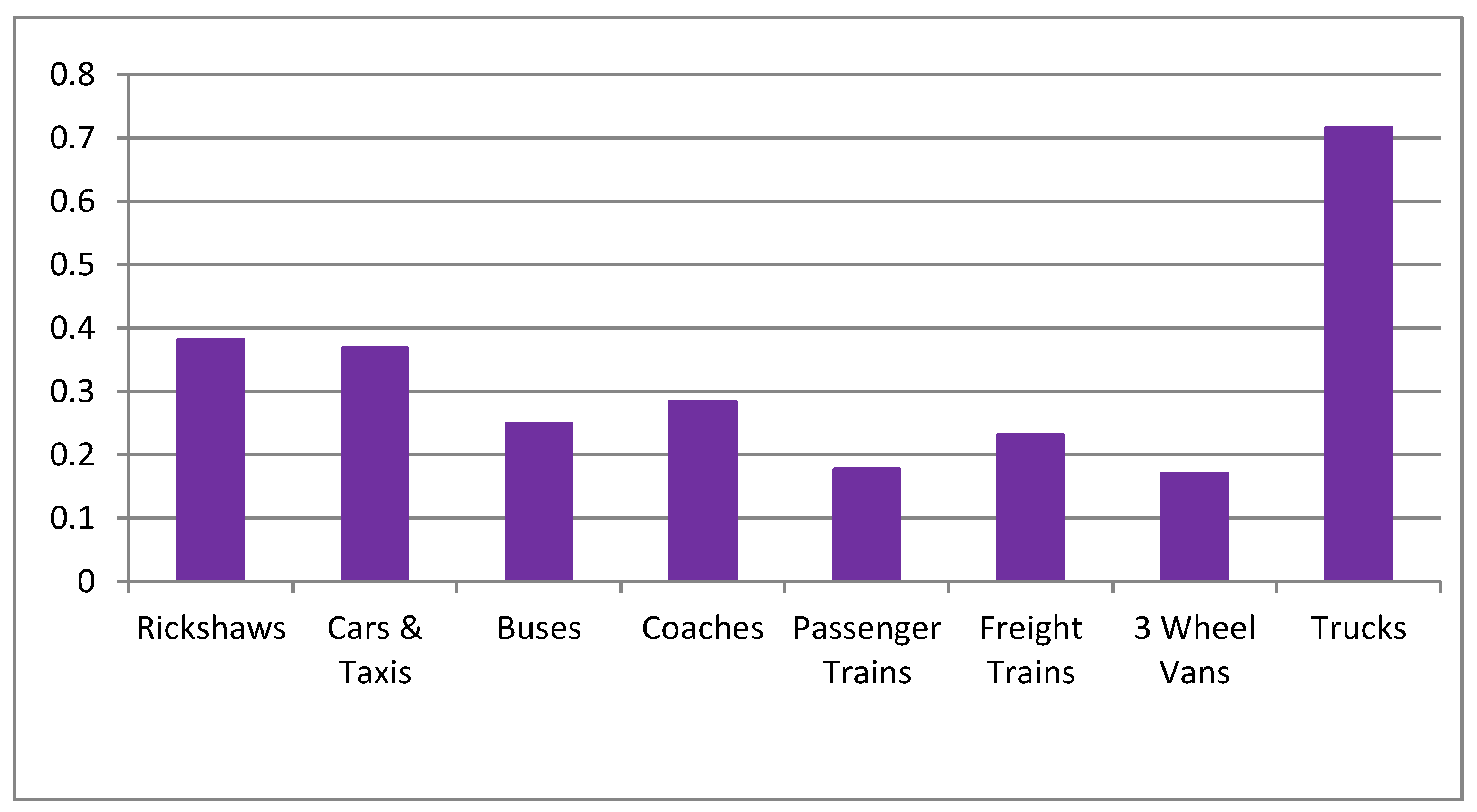
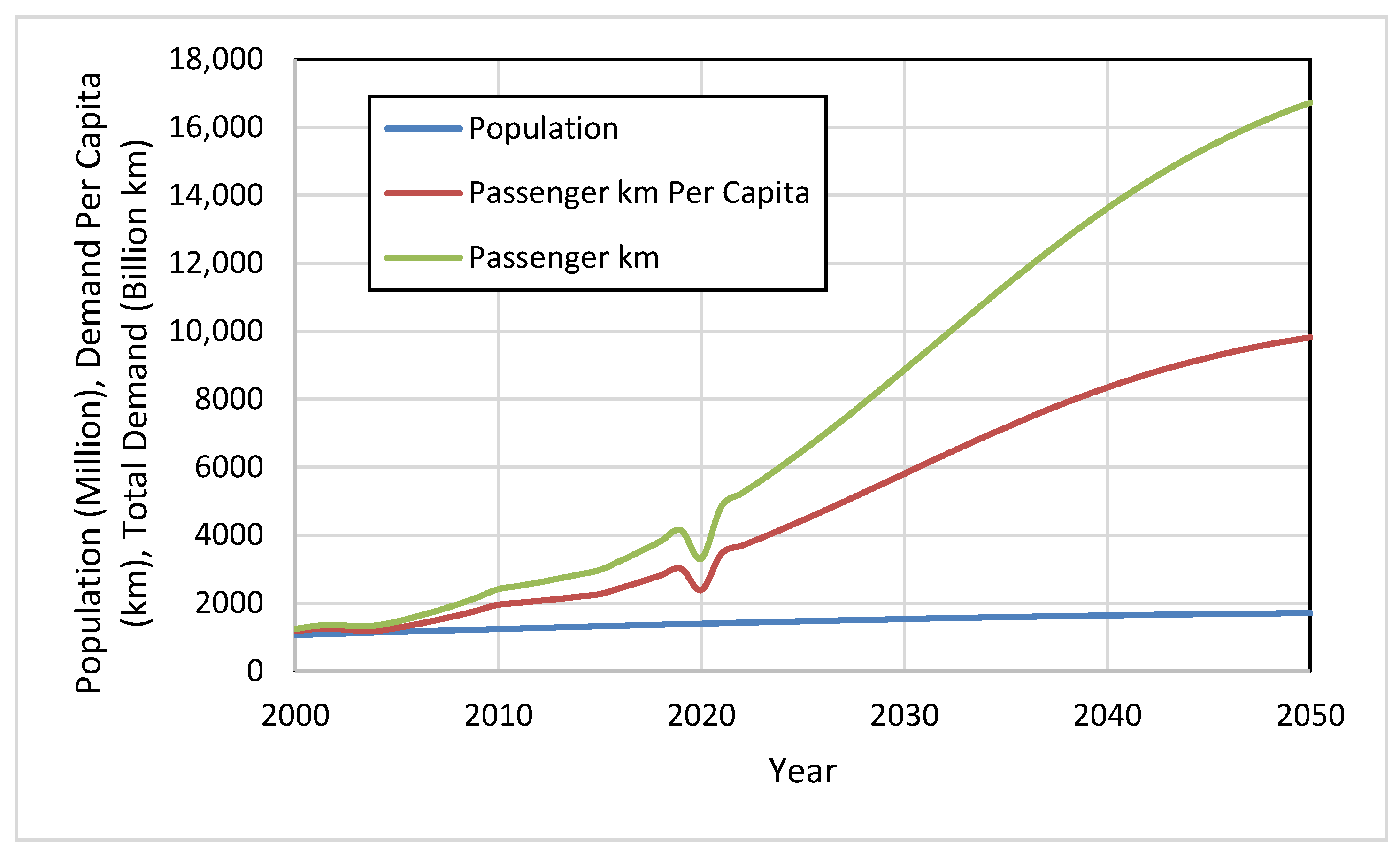
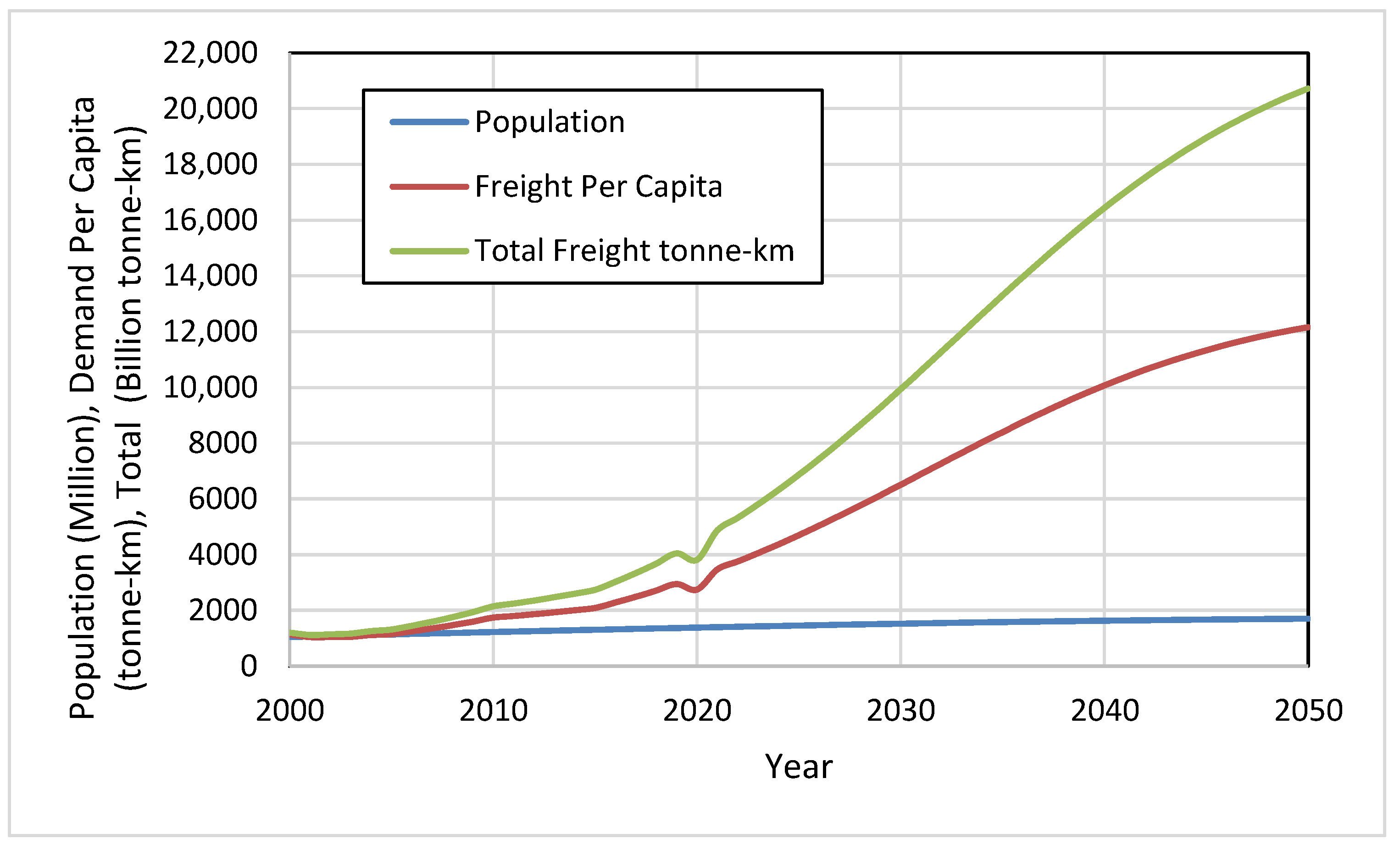
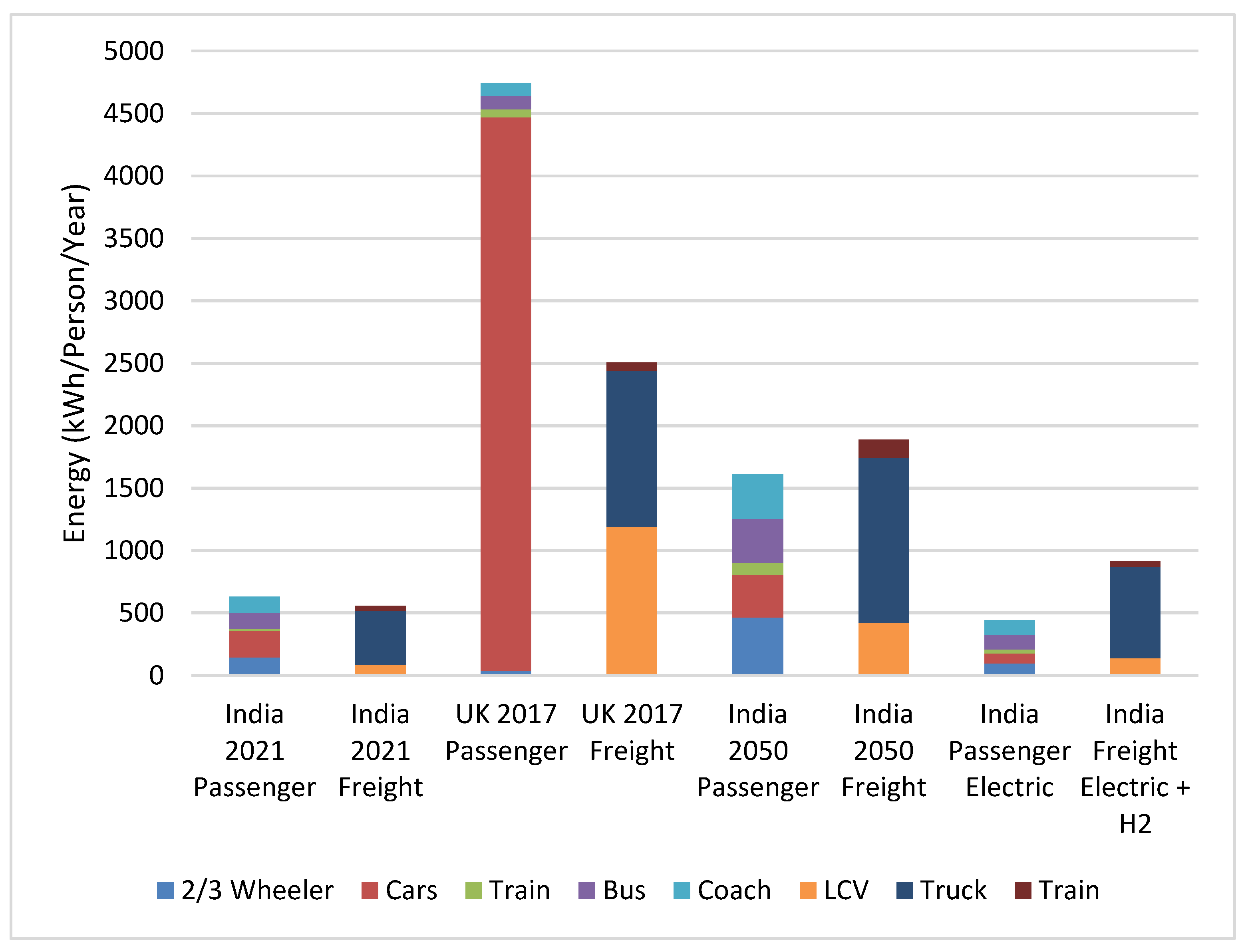
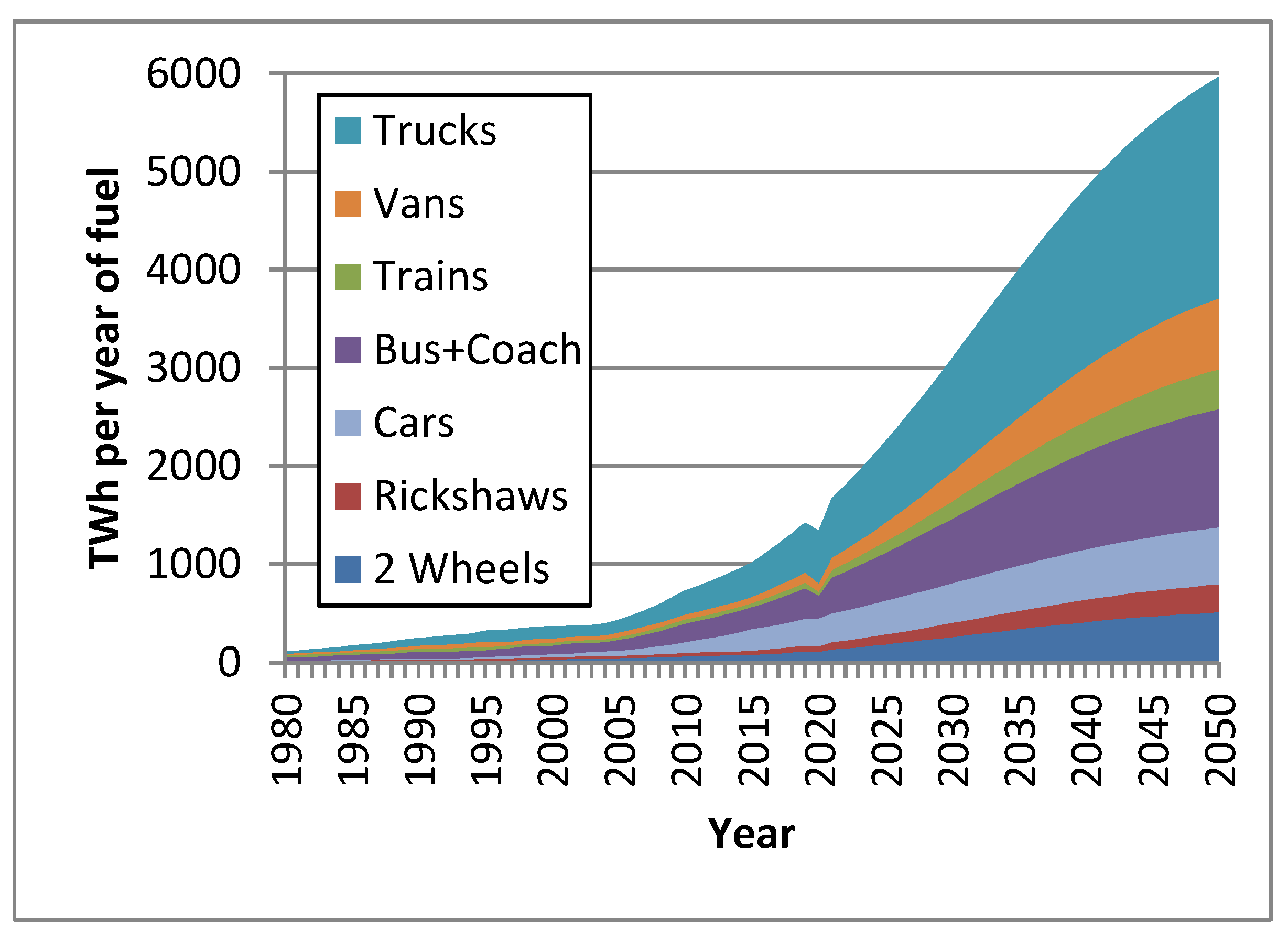
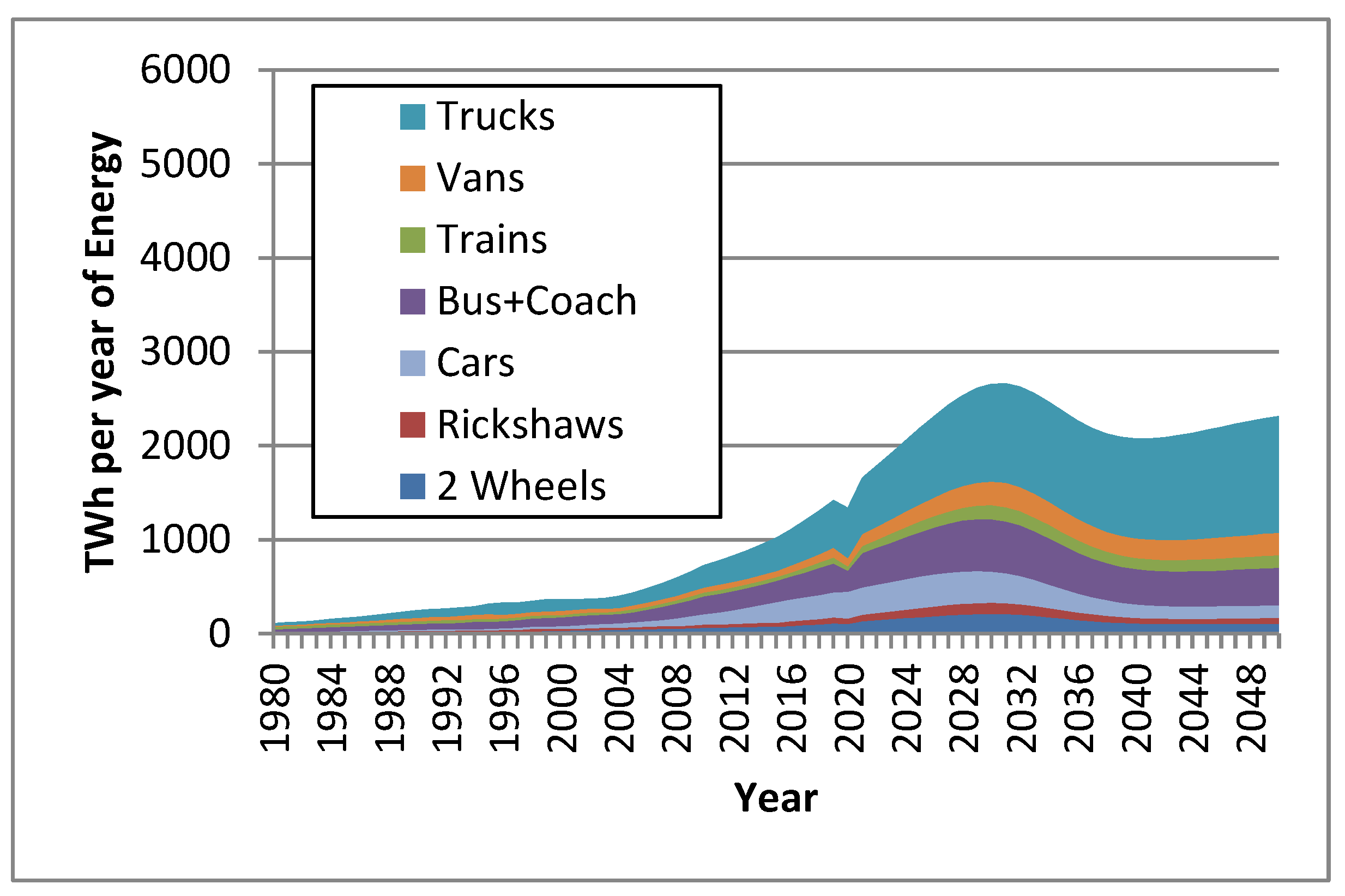
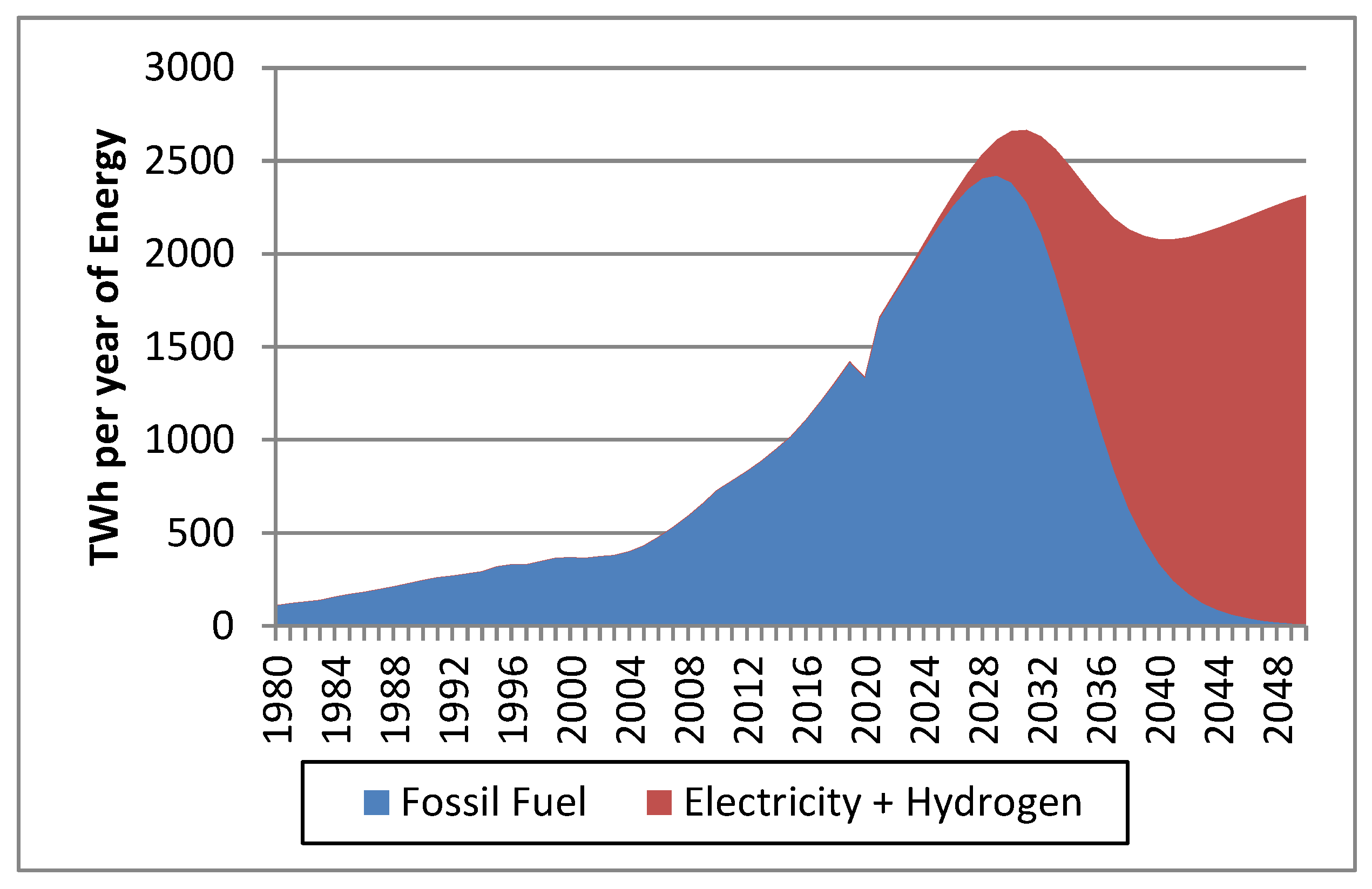
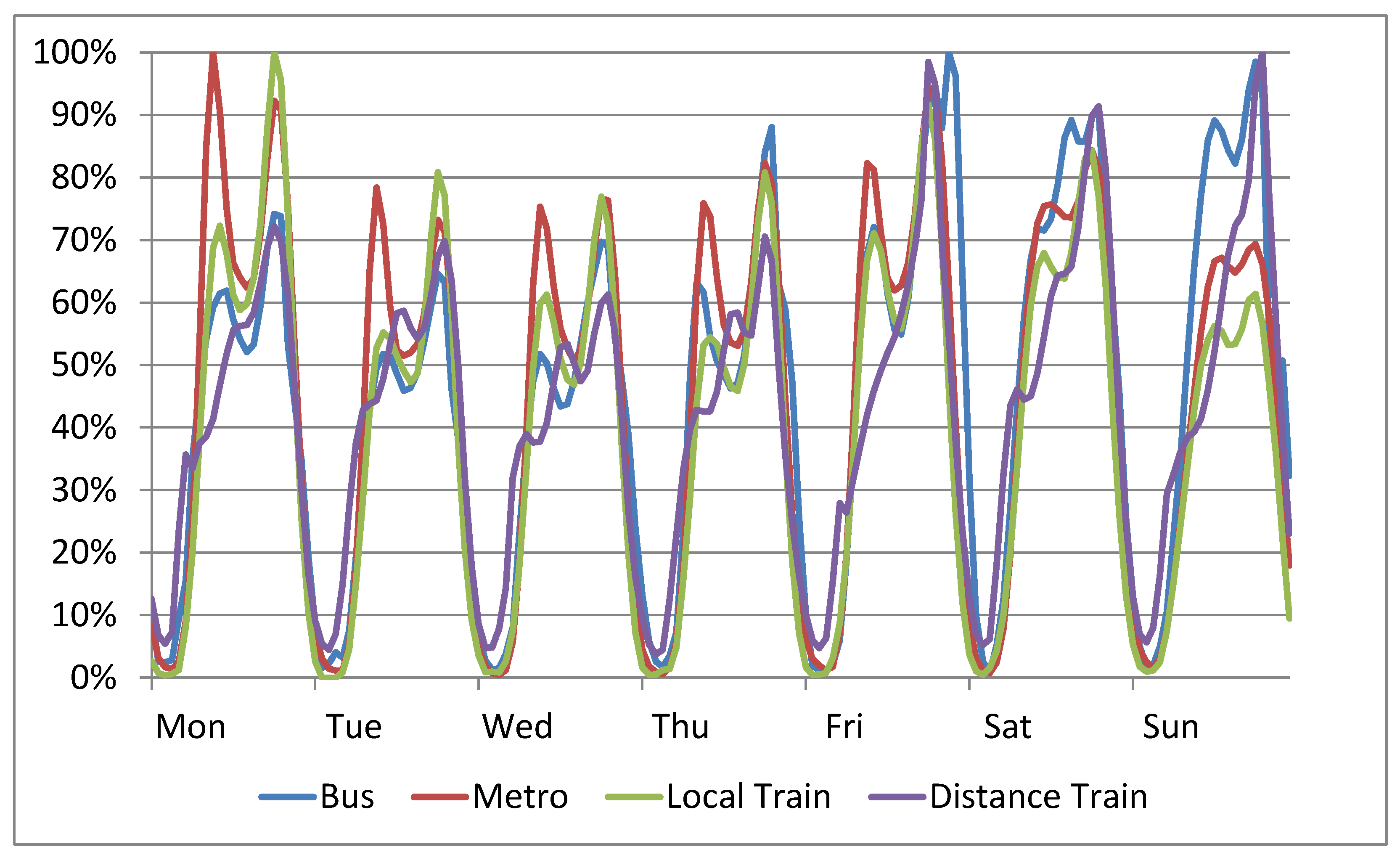
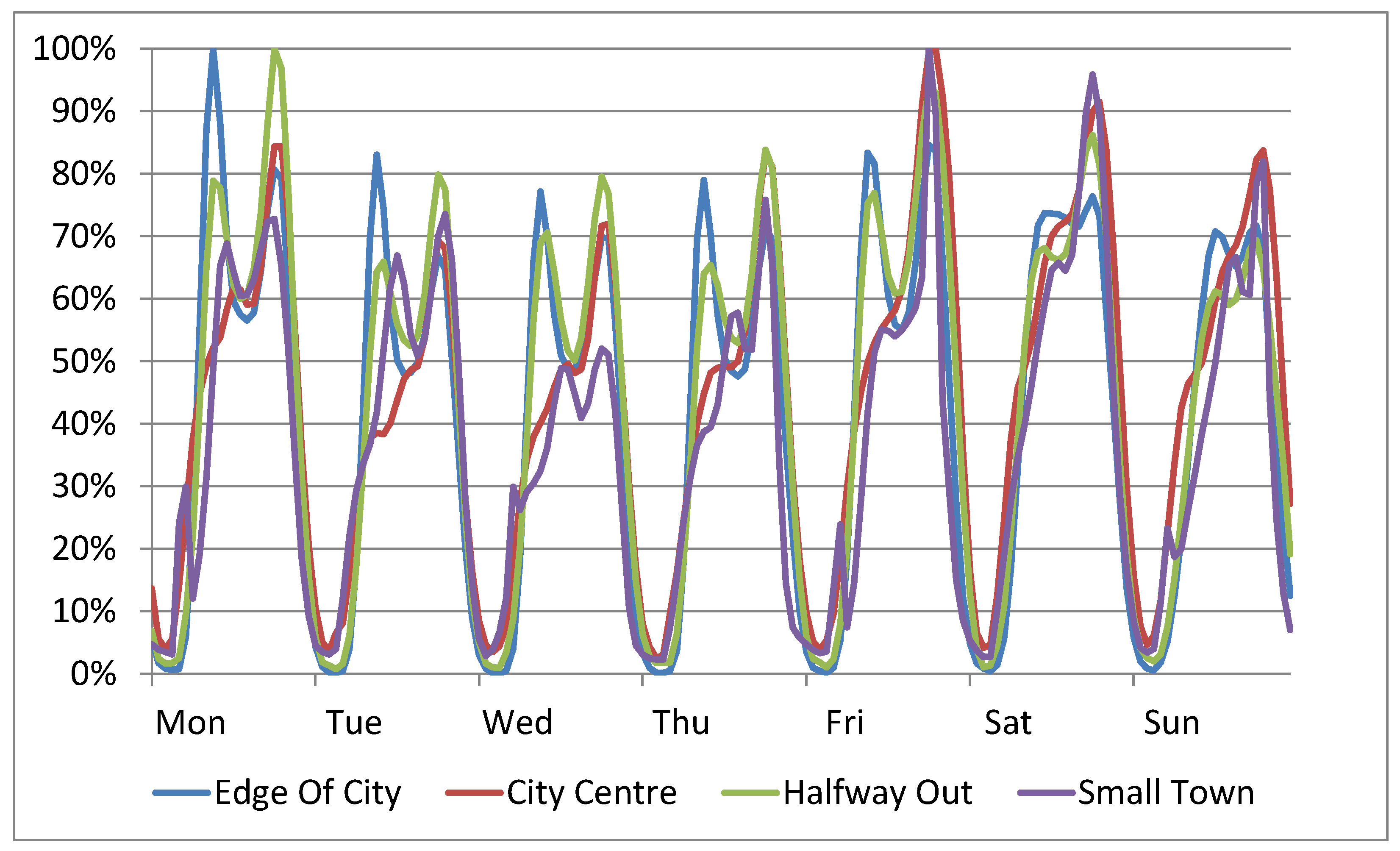


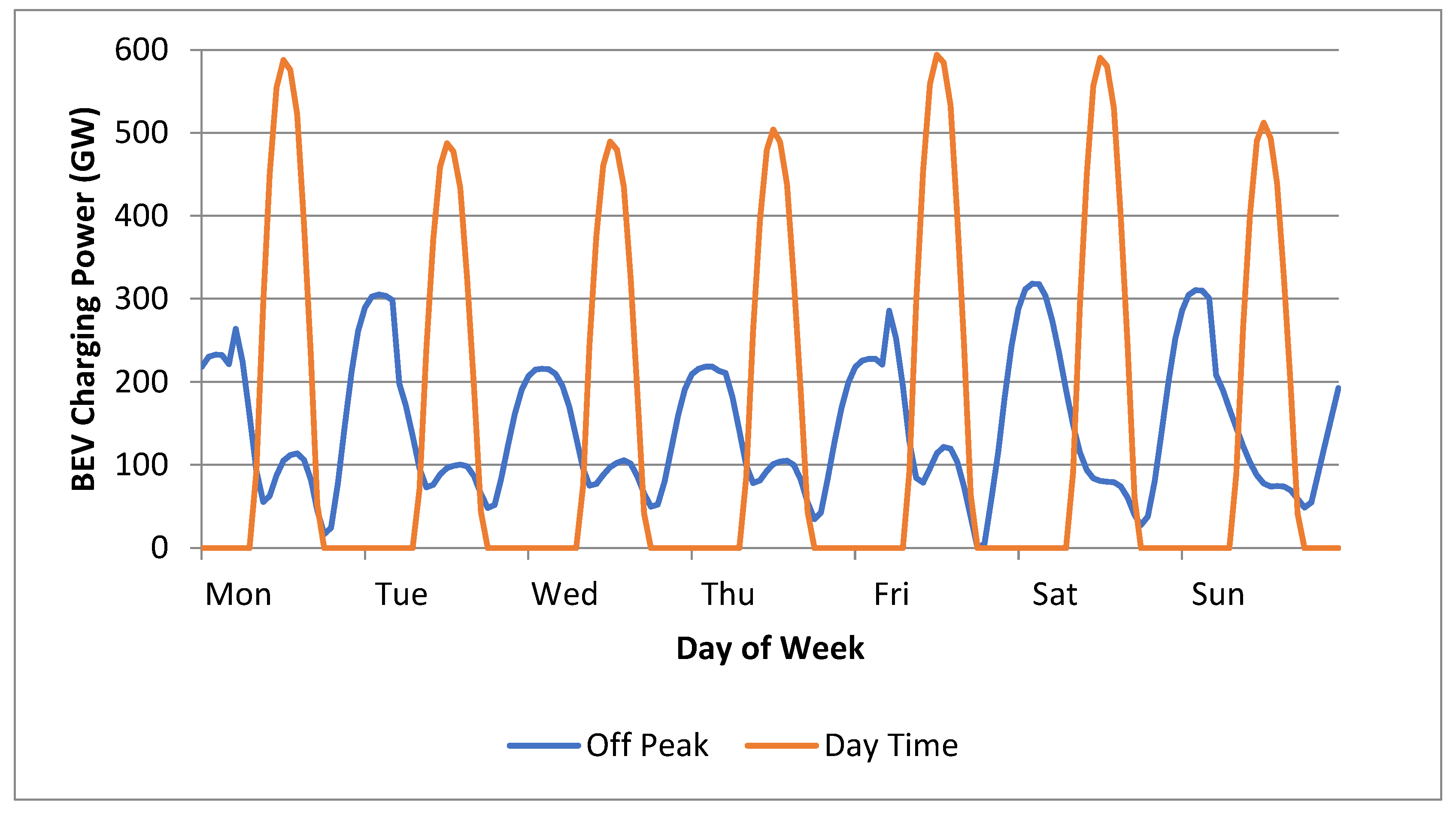
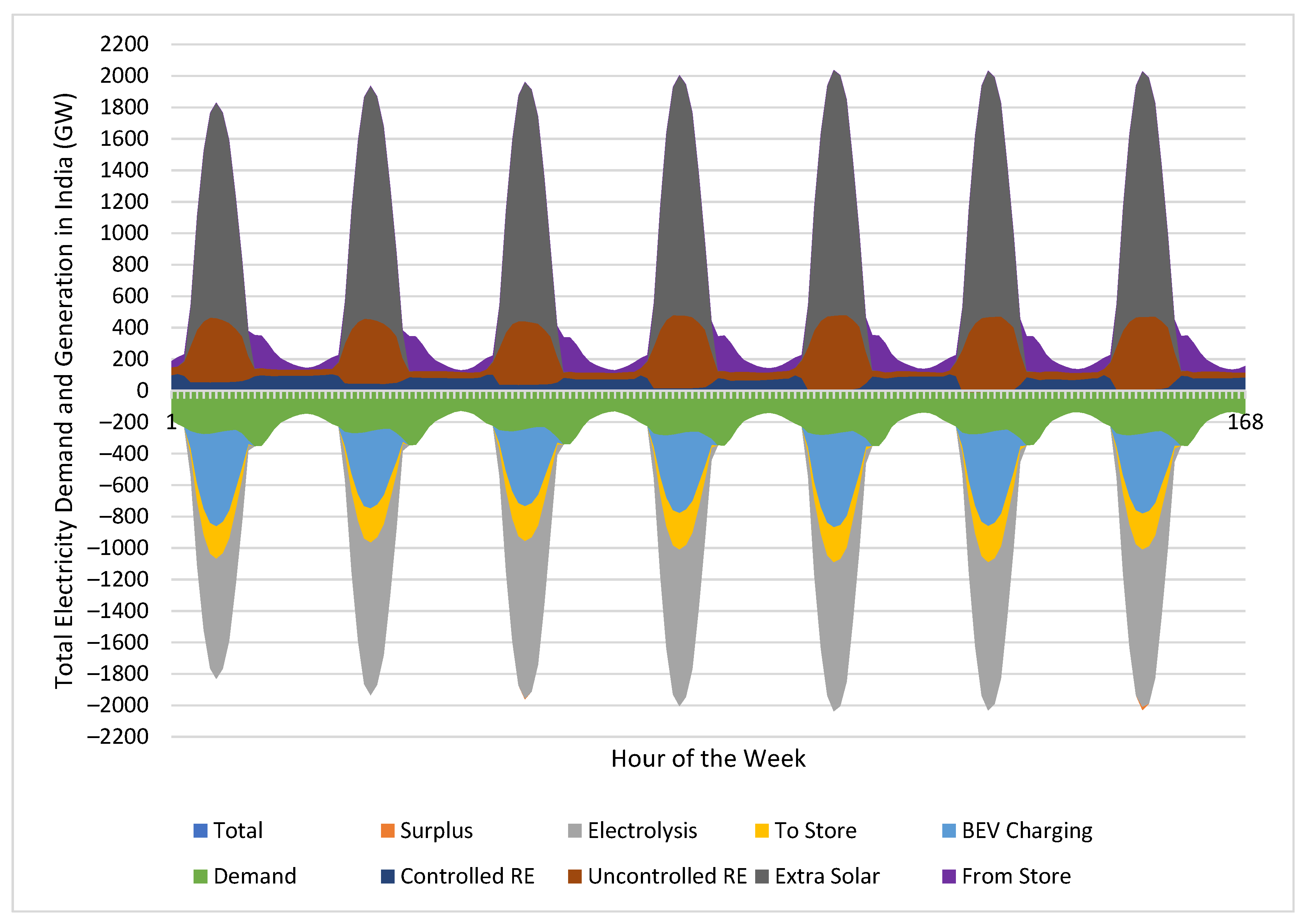

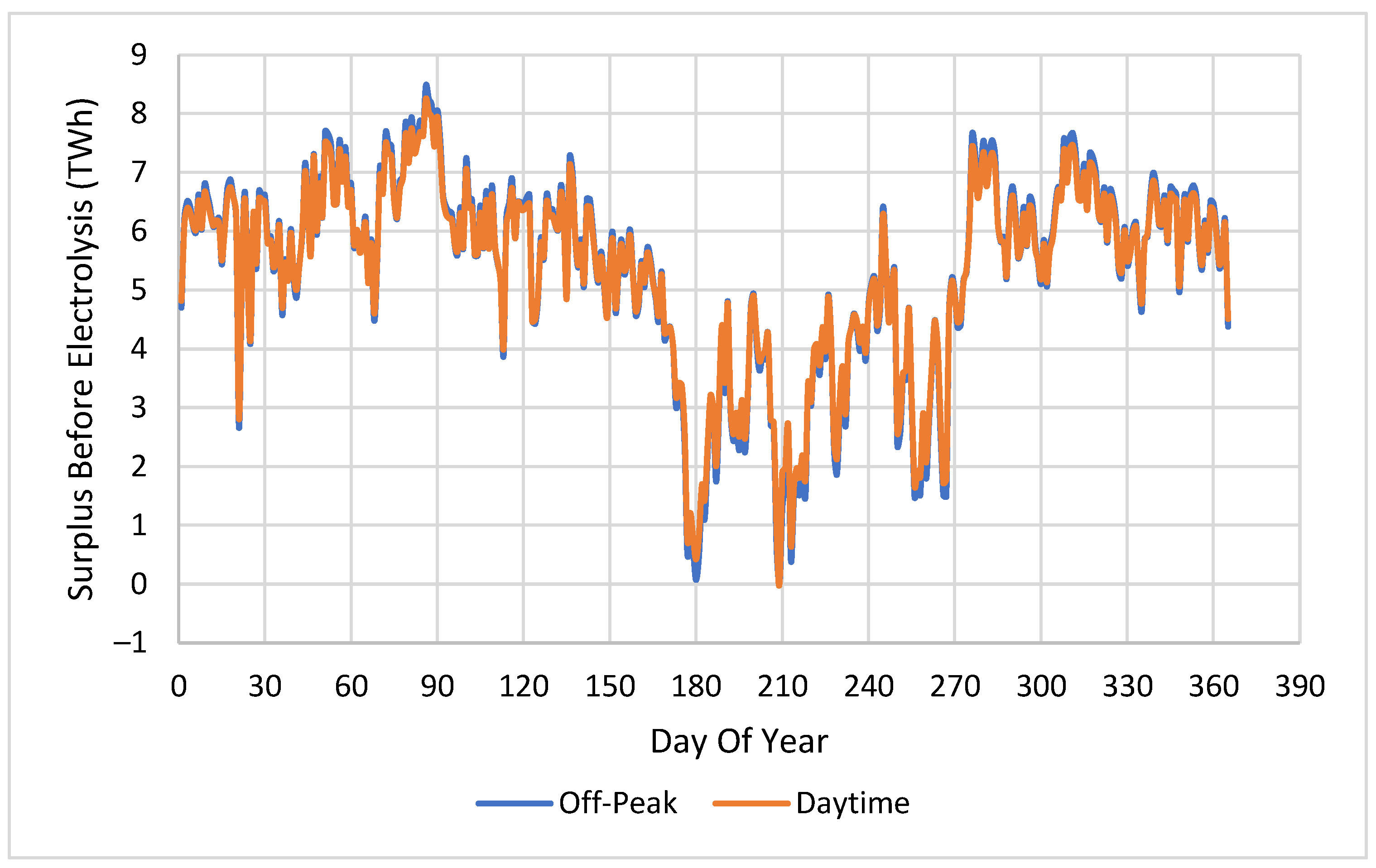
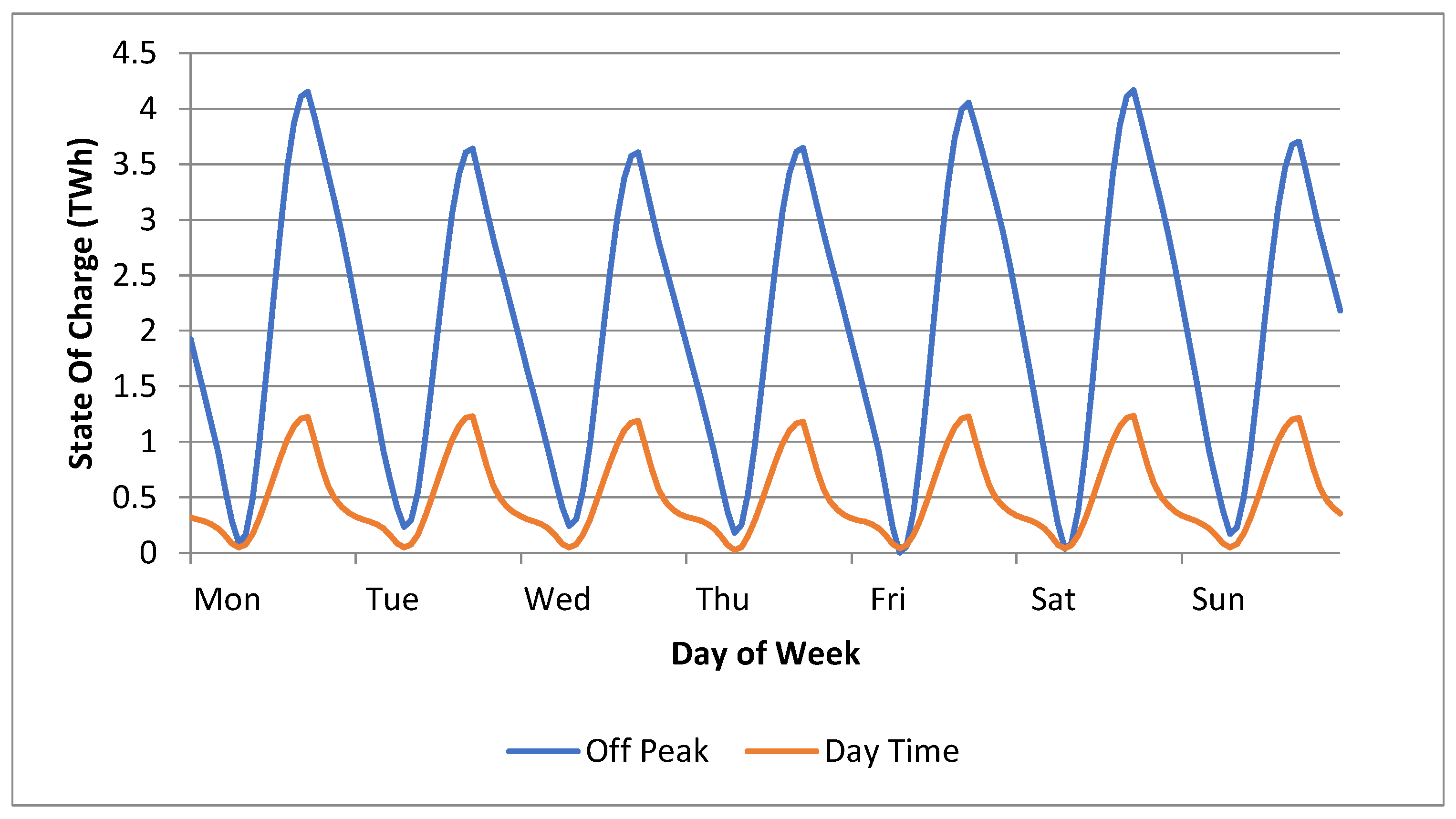
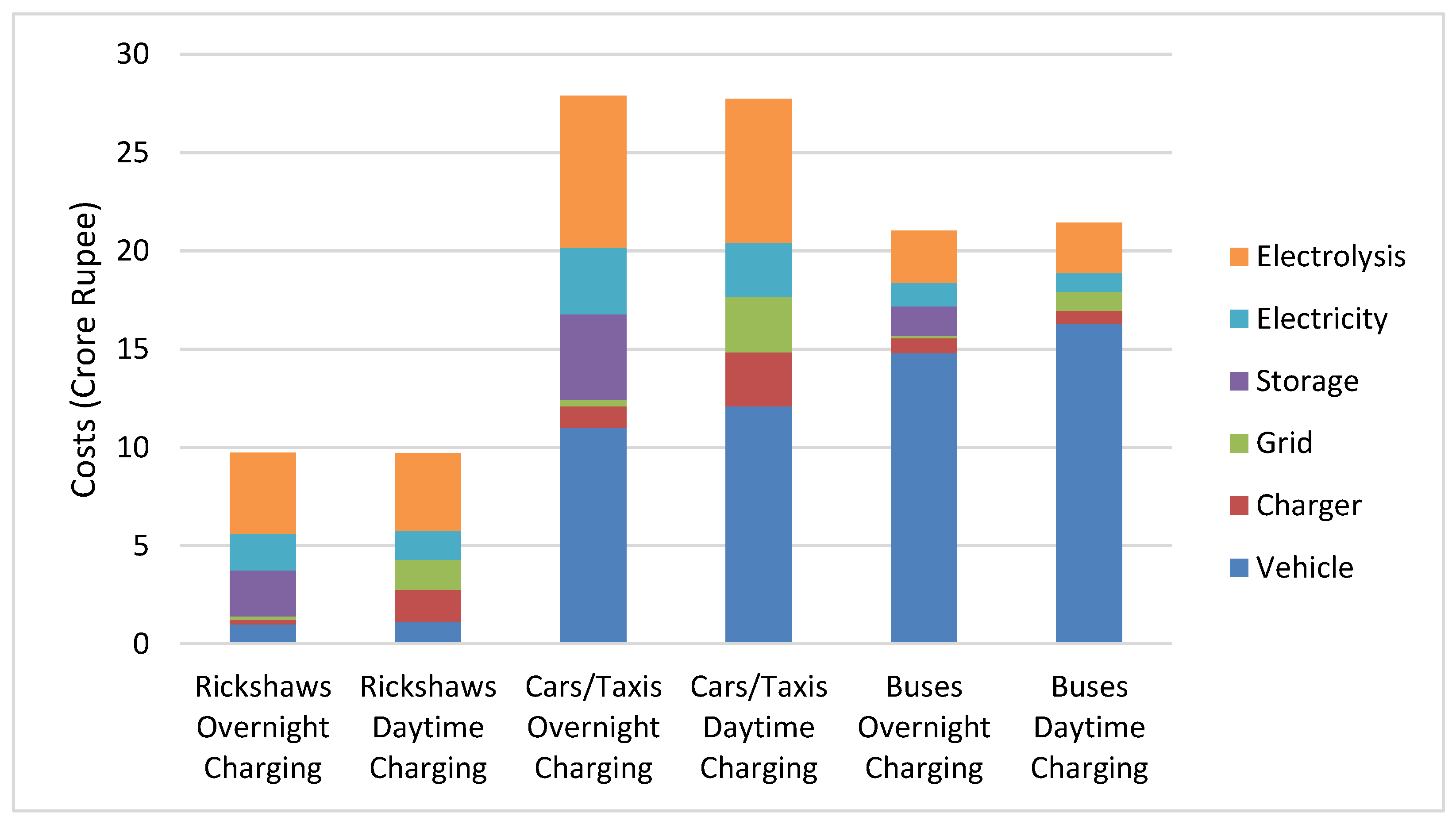
| Vehicle Type | Daily Range Travelled (km) | Specific Energy Consumption (kWh/km/Tonne) | Vehicle Curb Weight (Tonnes) | Maximum Laden Weight (Tonnes) | Battery Weight (Tonnes) |
|---|---|---|---|---|---|
| Auto Rickshaw | 105 | 0.86 | 0.272 | 0.610 | 0.104 |
| Car or Taxi | 199 | 0.71 | 0.895 | 1.270 | 0.336 |
| Local Bus | 125 | 0.22 | 5.36 | 10.84 | 1.34 |
| Coach | 400 | 0.22 | 15.20 | 20.50 | 4.30 |
| Passenger Train | 1200 | 0.050 | 1224 | 1368 | 217 |
| Freight Train | 1152 | 0.029 | 1394 | 3665 | 323 |
| Small Delivery Vans | 56 | 0.20 | 0.420 | 0.995 | 0.071 |
| Trucks | 441 | 0.14 | 8.88 | 34.00 | 5.55 |
| Aircraft | 10,400 | 0.23 | 277 | 650 | 3800 |
| Arguments for Daytime Charging | Arguments for Overnight Charging |
|---|---|
| Uses electricity at the same time of day as solar generation. This minimizes grid imbalance and the cost of necessary stationary energy storage. | Transport demand is much lower in the night-time hours than in the middle of the day. Therefore, the disruption to BEV operating schedules is minimal. |
| Simultaneous solar generation and BEV charging minimizes energy losses in charging and discharging stationary energy stores. | BEVs tend to return to a home or depot location at night in which dedicated charging points can be located. Conflict and competition over shared charge points can be avoided. |
| The gap between morning and evening commuting creates a window of lower transport demand in which BEVs can be recharged. | Charging takes place over more hours at lower power. The cost of each charge point is reduced, as is the cost of its grid connection. |
| Rapid (high power) charging minimizes the total number of charge points required. | BEV charging takes place when other electricity loads are at their minimum. Grid reinforcement costs are minimized. |
| Rapid chargers can be collocated with solar farms for the use of long-distance transport. This reduces the need for grid reinforcement. |
| Components of Generation | Components of Electricity Use |
|---|---|
| Uncontrolled generation (wind and solar), including extra solar PV to meet transport energy demands | Conventional electricity demand, adjusted for imports and exports |
| Controlled generation (large hydro and biomass) | |
| BEV Charging according to one of two profiles | |
| Discharge stationary storage to meet immediate shortfall in electrical power | Charge stationary storage to fill the store. Store is sized to meet all shortfalls over the year |
| Remaining surplus used for electrolysis to make hydrogen Remaining surplus above the power rating of the electrolysers is curtailed |
| Quantity | Off-Peak BEV Charging | Daytime BEV Charging |
|---|---|---|
| Energy Storage Capacity (GWh) | 4224 | 1319 |
| Storage Max Charge Rate (GW) | 837 | 240 |
| Storage Max Discharge Rate (GW) | 383 | 224 |
| Electrolyser Power (GW) | 1050 | 1000 |
Publisher’s Note: MDPI stays neutral with regard to jurisdictional claims in published maps and institutional affiliations. |
© 2021 by the authors. Licensee MDPI, Basel, Switzerland. This article is an open access article distributed under the terms and conditions of the Creative Commons Attribution (CC BY) license (https://creativecommons.org/licenses/by/4.0/).
Share and Cite
Barton, J.P.; Thomson, M. Solar Power and Energy Storage for Decarbonization of Land Transport in India. Energies 2021, 14, 8277. https://doi.org/10.3390/en14248277
Barton JP, Thomson M. Solar Power and Energy Storage for Decarbonization of Land Transport in India. Energies. 2021; 14(24):8277. https://doi.org/10.3390/en14248277
Chicago/Turabian StyleBarton, John P., and Murray Thomson. 2021. "Solar Power and Energy Storage for Decarbonization of Land Transport in India" Energies 14, no. 24: 8277. https://doi.org/10.3390/en14248277
APA StyleBarton, J. P., & Thomson, M. (2021). Solar Power and Energy Storage for Decarbonization of Land Transport in India. Energies, 14(24), 8277. https://doi.org/10.3390/en14248277






